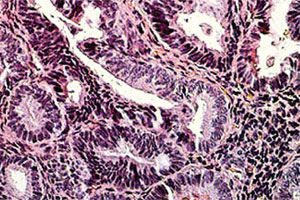The uterus is pear-shaped and is found above the bladder and rectum.In an adult woman it presents thick walls and a wrinkly surface with a length of nearly eight centimeters.Its maximum size is reached during adulthood; as the years go by, after menopause it diminishes little by little. Its main function is to house and nourish the developing embryo until the moment of its birth. It is made up of three important layers. The outermost is a serous membrane dubbed perimetrium, which is the part of the peritoneum that lines the uterus. The intermediary smooth muscle layer made up by the myometrium is of great importance to both menstruation and childbirth. In both processes its powerful fibers have the capacity to contract strongly, expulsing the menstrual waste (made up of part of the endmetrium, some uterine cells and the unfertilized ovule) or fetus, respectively.
The last and innermost layer is known as the endometrium, mucous lining rich in blood vessels whose appearance varies with age and the menstrual cycle.During this last process and under the command of certain hormones (basically progesterone), it thickens its walls to approximately six millimeters, ready to receive and nourish the fertilized ovule in the first stage.The inferior and narrowest part of the uterus is called cervix or uterine neck. Tube-shaped and with a length of close to 2.5 centimeters, it is the two-way lane for certain bodily fluids. Being in direct contact with the vagina, it serves as an evacuation route for the menstrual fluid and a reception and conduction space for the spermatozoa. But its reproductive task doesn’t end there because the cervix houses important mucus secreting glands, substance that aids the survival of the male gametes for two or three days after the sexual relation. It is also an excellent defensive barrier against the entry of pathogen organisms, except during the menstrual or ovulation period.
Vagina
It is a tube-shaped structure made p of muscles and membranes that extends from the vulva to the cervix, beneath and behind the bladder and in front of and above the rectum.It is a deep cavity, approximately eight centimeters long and a width that varies according to its dilation. Being elastic and of easy expansion, the vagina participates in two important reproductive moments: it receives the penis during sexual intercourse and evacuates the fetus at childbirth.The vaginal wall is lined by the vaginal mucosa, which firmly adheres to a layer of smooth muscle. It contacts the outside through the vaginal orifice, located a little bit behind the urinary meatus. This opening is covered by a membranous fold in women who have not had sexual relations, the hymen, which can close it totally or partially.








 Muere Evita
Muere Evita